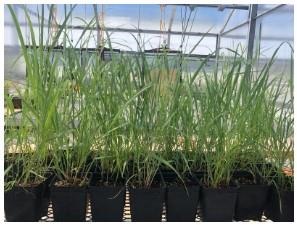Kim is the lead author of a new study that explores how soil conditions, like moisture level and pore size, can affect soil microbes. Understanding how different soil conditions impact microbial activity can give researchers a better handle on ways to increase soil health and fertility, and help combat climate change. For example, “it can be a critical part in reducing greenhouse gas emissions from agricultural fields after harvests,” says Kim.
Kim recently presented her work at the 2022 ASA-CSSA-SSSA annual meeting, held in Baltimore, Maryland.
Kim and her colleagues at Michigan State University compared microbial activity near corn and switchgrass leaf litter. Corn is a vital crop, and farmers in the United States planted nearly 90 million acres in the 2022 growing year. Switchgrass is a promising bioenergy crop with an expanding footprint. “Also, corn and switchgrass have different litter characteristics,” says Kim. “Litter chemistry affects how easily microbes can decompose different litters. The physical characteristics like texture can affect the water and air environment near litters.”

Kim and her colleagues found that corn and switchgrass litters differ in how they change moisture levels in the soil near them. “We found distinct moisture depletion 0.1 to 1.5 millimeter away from switchgrass residues,” says Kim.
To study this moisture distribution, Kim used a method called X-ray and Neutron computed tomography. This method works very similarly to medical CT scans. “It’s a very promising, non-destructive way to study soils and water in them,” says Kim.
It turns out, moisture content is one of the most important factors influencing soil microbial activity. That’s because one way that microbes decompose organic material, like leaf litter, is by releasing chemicals called enzymes. Different enzymes break down different materials. For example, an enzyme called beta-glucosidase can break down plant cell walls. Another enzyme called chitinase can break down the exoskeletons of insects and some fungi. Once the enzymes break down their target materials into simpler chemicals, soil microbes can feast.
Click here to see more...